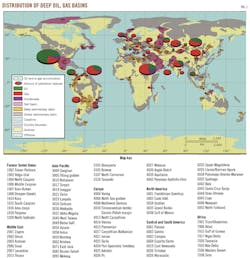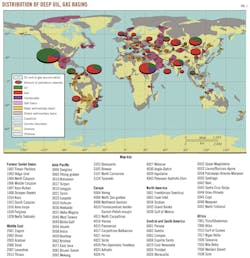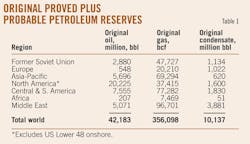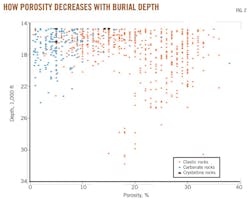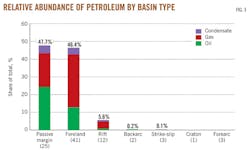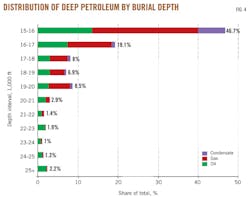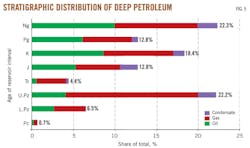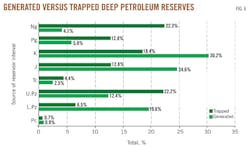More attention recommended for global deep reservoirs
Binfeng Cao
Guoping Bai
Yifan Wang
China University of Petroleum
Beijing
Exploration for deep oil and gas accumulations, which refers to those at burial depths of no less than 15,000 ft (about 4,572 m), deserves more specialized attention. Excluding the US onshore Lower 48 states, 87 major sedimentary basins are identified to host deep petroleum accumulations throughout the world.
North America contains the largest quantities of the discovered deep petroleum with original proved plus probable (2P) reserves of 28.06 million bbl of oil equivalent.
The three most prolific basins for deep petroleum are the Gulf of Mexico, Arabian, and East Venezuela basins. These three basins contain 48.6% of the total deep original 2P petroleum reserves in the world.
Of that figure, 63.3% is reservoired in clastic rocks, 35% in carbonates, and 1.7% in crystalline rocks. In terms of trap type, 95.7% of the total is in structural and combination traps.
Passive margin and foreland basins contain the bulk of the world's deep original 2P petroleum reserves, with the former accounting for 47.7% of the total and the latter 46.4%.
Salt-bearing deep sedimentary basins are significantly more prospective for deep petroleum than basins without salt. This is attributed to the relative cooling effect for the subsalt sediments induced by salt. The effect is responsible for retardating source rock maturation in the deep parts of petroliferous basins.
The petroliferous basins in the Tethyan realm contain 85% of world total deep original 2P petroleum reserves, which is similar to the distribution of petroleum in shallow-intermediate reservoirs.
Some 92.3% of the total occurs in reservoirs with burial depths of 15,000 ft (about 4,572 m) to 20,000 ft (about 6,096 m).
Stratigraphically, the deep petroleum reserves are largely confined to five reservoir intervals: Neogene (hosting 22.3% of the total), Upper Paleozoic (22.2%), Cretaceous (18.4%), Paleogene (12.8%), and Jurassic (12.8%).
The concentration of deep petroleum reserves in the Jurassic-Tertiary reservoir rocks may be a direct result of widespread availability of more effective source rocks in these stratigraphic intervals.
There exists an objective similarity in the stratigraphic distribution of generated and trapped original reserves for both deep and shallow-intermediate petroleum. Therefore, we suggest that deep petroleum exploration should target the play fairways where substantial shallow-intermediate petroleum reserves have already been discovered.
Introduction
Deep petroleum is defined as oil and-or gas occurring in reservoirs at burial depths of no less than 15,000 ft (about 4572 m).1
Exploration for deep oil and gas accumulations deserves more specialized attention, not least because these petroleum accumulations widely occur in the deep parts of sedimentary basins on a global scale. Compared to shallow-intermediate petroleum, exploration of deep petroleum is an issue involving both commercial and scientific challenges.
Efficiently locating deep hydrocarbons depends on understanding geological characteristics of deep sedimentary basins (or deep reservoirs), continued advances in drilling and completion technologies, and associated finding costs.1-4
Studies of deep oil and gas have been going on for a long time. Perhaps the latest and most detailed exercise was that by Dyman et al.1 Their discussion of estimated mean quantities and location of worldwide deep petroleum resources focused more on undiscovered conventional natural gas and its regional distribution. In this study, the primary measure is barrels of oil equivalent (BOE) of original petroleum reserves, which are separated into oil, gas, and condensate where appropriate. Unconventional resources are not counted.
In this study, excluding the US onshore Lower 48 states, we have identified 87 major deep sedimentary basins containing discovered deep petroleum (Fig. 1). The identified amount is the original proved plus probable (2P) reserves of deep oil, gas, and condensate.
Rather than attempting an encyclopedic coverage of these productive basins, we analyze general geological characteristics of deep petroleum accumulations such as hydrocarbon types, reservoir rocks, and trap types. Maps constructed on a global scale illustrate the regional distributions of deep oil and gas accumulations and deep sedimentary basins.
At the same time, we focus more on the distributions of deep oil, gas, and condensate original 2P reserves by principal geographic region and basin type, burial depth, and stratigraphic interval. On these bases, we discuss how salt affected the preservation of source rocks (hydrocarbons) in the deep parts of sedimentary basins and why different basin types and stratigraphic intervals show significant differences in the prolific distribution of deep petroleum reserves when compared with shallow-intermediate petroleum.
Deep hydrocarbon types
Conventional petroleum is widely distributed in the deep parts of sedimentary basins, and it is separated into oil, gas, and condensate by hydrocarbon phase or type.
The deep oil, gas, and condensate original 2P reserves are 42 billion bbl of oil, 356 tcf of gas, and 10 billion bbl of condensate (Table 1), making up 1.9%, 3.6%, and 2.1% of the world (excluding the US onshore Lower 48) total oil (2,285 billion bbl), gas (10,002 tcf), and condensate (482 billion bbl).
Significant oil production, emphatically, occurs in deep conventional reservoirs and may be associated with low subsurface temperatures and low thermal maturation related to cool meteoric water penetrating deep into the basins along bounding faults,5 overpressure,6-8 and salt deposits.9-13
Reservoir rock types
In this study, deep petroleum reservoirs were divided into three categories: clastic, carbonate, and crystalline rocks.
Thus, the productive effectiveness of each category of reservoirs can be quantitatively expressed as a percentage of the world total deep original 2P petroleum reserves hosted in these rocks. Of these, 63.3% of the total is reservoired in clastic rocks, 35% are in carbonate rocks, and igneous and metamorphic rocks host only 1.7%.
Propelled by advances in drilling technology, seismic imaging, and better understanding of deepwater turbidite reservoirs, major deep petroleum discoveries have been made in deepwater and ultradeepwater areas in the last decade. The Gulf of Mexico has been only a part of the global offshore boom.
Significant exploration and development has also taken place off the coasts of Brazil and the West Africa, Russia, Norway, and Canada are speeding up similar projects. At present 23.7% of the world total deep original 2P petroleum reserves are from deepwater and ultradeepwater turbidites. Passive margins host 83.4% of all turbidite discoveries. It can be expected that deep-marine turbidite plays will continue to be pursued in deep petroleum exploration in passive margins.
Porosities systematically decrease with the burial depth for all significant deep reservoirs, although the range of porosity values at a particular depth varies considerably (Fig. 2). Of the significant deep reservoirs documented here, clastic reservoirs generally exhibit the highest porosities. All prolific reservoirs deeper than 24,000 ft (about 7,315 m) are sandstone reservoirs, and they have porosities of 18-30%. The Tertiary deep-marine turbidite sandstones in the Gulf of Mexico largely predominate these deeper sandstone reservoirs.
Trap types
Most deep petroleum accumulations are contained in structural and combination traps. About 73.8% of the total are hosted in structural traps. Combination traps contain 21.9%, and only 4.4% are in stratigraphic traps.
Even though structural and combination traps contain the bulk of the discovered deep petroleum, it is truly unadvisable that stratigraphic traps should be ignored and even avoided in deep petroleum exploration. Significant deep reservoirs associated with stratigraphic trap or unconformities, particularly in carbonate reservoirs, have continued to be discovered.
Supergiant Karachaganak field in the North Caspian basin and giant Longgang field in the Sichuan basin are two examples of recent deep petroleum discoveries that are characterized by the stratigraphic trap type and the carbonate reservoir.
Distribution by basin type
Of the seven regions in the worldwide assessment, North America, excluding the US onshore Lower 48, contains the largest quantities of the discovered original 2P reserves of deep oil, gas, and condensate (28.06 million boe) (Table 1). It is followed by the Middle East (25.069 million boe) and then Central and South America (22.265 million boe).
Furthermore, North America is also the most prolific region for deep oil reserves (20.225 million bbl) with the bulk found in the deepwater and ultradeepwater Gulf of Mexico. The Middle East has the largest share of deep gas (96,701 bcf) and condensate reserves (3.881 billion bbl) with the Arabian basin containing 56% of the deep gas.
The distribution of the 87 sedimentary basins with deep petroleum accumulations in the world is shown in Fig. 1. The pie size represents the quantities of deep oil, gas, and condensate original 2P reserves of the 48 more prolific deep basins, each of which contains an original 2P petroleum reserve of more than 50 million boe.
The three most prolific basins for deep petroleum are the Gulf of Mexico (27.593 million boe), Arabian (15.192 million boe), and East Venezuela basins (11.521 million boe), and together they host 48.6% of the world total. The maximum burial depth of deep petroleum reservoirs is 32,808 ft (about 10,000 m), which is recorded in the Gulf of Mexico basin.
In this study, we classified the 87 deep sedimentary basins into seven widely used types: continental rift, passive margin, intracratonic, foreland, forearc, backarc, and strike-slip. The classification scheme is the simplification of the basin categories of Ingersoll and Busby.14
Passive margin and foreland basins are the interpreted types for 66 of the 87 deep basins, with the rift basins of 12. Passive margin and foreland basins contain the bulk of the world total, with the former accounting for 47.7% and the latter 46.4% (Fig. 3).
It is probably fair to say that passive margin and foreland basins have stolen the show as petroleum exploration has moved into the deep parts of sedimentary basins.
Due to special tectonic settings of basins of various types,15-19 passive margin, foreland, and rift basins tend to become more sediment-nourished or deeper, thus becoming more likely to be qualified as deep sedimentary basins when compared with most of intracratonic sags, and strike-slip, forearc, and backarc basins.
Basins with high deep petroleum yield in any type are often attributable to special characteristics that enhance the essential elements of source, reservoir, seal, and trap for petroleum accumulations. Special characteristics appear to reach an optimum in passive margin and foreland basins.
Many prolific salt basins still produce large quantities of hydrocarbons in the deeper parts today when thermal simulations that do exclude salt effects indicate that most of known deep source rocks should be overmature. This is well corroborated in our statistics, as 33 of the 87 deep sedimentary basins are salt basins (Fig. 1).
These 33 salt basins contain 65.8% of the world total original 2P reserves of deep petroleum, emphatically, with deep oil reserves accounting for 75.9% of the world total deep oil original 2P reserves. Passive margin and foreland basins are the interpreted type for 29 of these 33 salt basins, and the other four are rift basins. This statistics may also explain why deep petroleum exploration has taken the spotlight from passive margin and foreland basins on a global scale.
The more prolific of these salt basins for deep petroleum are the Gulf of Mexico, Arabian, Tarim, Zagros, Oman, North Caspian, North Sea Graben, Dnieper-Donets, Santos, Northwest German, and Levantine basins, each with deep original 2P petroleum reserves of more than 1,000 million boe. The original 2P reserves of deep petroleum in these 11 basins amounts to 63.7% of the world total, with deep oil reserves accounting for 74.4% of the world total deep oil reserves.
The presence of thick salt deposits and-or associated structures resulted in a "cooling" effect for the sedimentary successions underlying the salts when compared with basins without salt. The resulting regional cooling effect, which could last as long as these salt structures remain, would slow or restrain the maturation of subsalt source rocks or delay the conversion of trapped oil to gas in deep parts of salt basins.9-13
Additionally, we notice that most of the basins hosting rich original reserves of deep petroleum occur in the Tethyan realm (Fig. 1). The Tethyan basins contain 85% of the world total deep original 2P petroleum reserves. Rich original petroleum reserves of the Tethyan realm might thank to the high effectiveness of source rocks that were deposited in low latitudes.20
Furthermore, the characteristic distribution of original reserves of the world deep petroleum is considerably similar with the distribution of the world petroleum documented by Klemme and Ulmishek.20 Considering the widespread unavailability of deep and ultradeep well drilling on a global scale and the inability of associated methodologies to be used to assess deep petroleum prior to 1990, this influential work can be viewed as an exhaustive study of the world shallow-intermediate petroleum. So the areas where substantial shallow-intermediate petroleum reserves have already been discovered tend to have greater exploration potential for deep petroleum.
Distribution by burial depth
The original 2P reserves of oil, gas, and condensate contained in deep reservoirs systematically decrease with burial depth (Fig. 4).
About 92.3% of the world total occurs in the burial depth interval of 15,000 ft (about 4,572 m) to 20,000 ft (about 6,096 m). Ultradeep original petroleum reserves (at burial depths of greater than 25,000 ft, about 7,620 m, defined by Dyman1) account for just 2.2% of the total.
Such a distribution may be directly linked with the variation in porosity of deep reservoirs with the burial depth illustrated in Fig. 2.
Distribution by stratigraphic interval
Fig. 5 illustrates the stratigraphic distribution of effective deep reservoir rocks given as a percentage of the total original 2P reserves of deep oil, gas, and condensate in the world. The more prolific intervals are Neogene (hosting 22.3% of the total), Upper Paleozoic (22.2%), Cretaceous (18.4%), Paleogene (12.8%), and Jurassic (12.8%). These five principal reservoir intervals contain 88.4 % of the world total.
Because of deep gas continuing to be more important volumetrically with geologic age, older reservoirs are still highlighted as significant targets for deep gas.
Far from coincidence, the concentration of deep petroleum reserves in Jurassic-Tertiary reservoir rocks may be a direct result of widespread availability of more effective source rocks in these stratigraphic intervals, as documented by Klemme and Ulmishek.20
Fig. 6 shows the deep original 2P petroleum reserves entrapped in stratigraphic intervals of various ages compared with petroleum reserves generated by the same age intervals. The older source intervals generally contributed smaller proportions of original petroleum reserves than younger source rocks (mainly Jurassic and Cretaceous). This may be associated with the preservation and thermal maturity level of source rocks.
The overall trend of migration of generated petroleum from source rocks into reservoirs is also illustrated in Fig. 6. The apparent mixing of petroleum originated from multiple sources within individual reservoir intervals is clearly presented.
Of these more prolific intervals of the Neogene, Upper Paleozoic, Cretaceous, Paleogene, and Jurassic, the Neogene, Upper Paleozoic, and Paleogene intervals contain more petroleum than generated by themselves. In contrast, the Cretaceous and Jurassic host less petroleum than generated by themselves. So the sharply uneven stratigraphic distribution of deep petroleum is considerably attributed to the availability of effective source rocks.
Other factors such as characteristics of hydrocarbon migration also determine to some extent a specific stratigraphic range of petroleum prolificacy in different basins. Additionally, there exists an objective similarity in the stratigraphic distribution of generated and trapped original reserves for both deep and shallow-intermediate petroleum.20 Therefore, we suggest that the deep petroleum exploration should target the play fairways where substantial shallow-intermediate petroleum reserves have already been discovered.
Manuscripts welcomeOil & Gas Journal welcomes for publication consideration manuscripts about exploration and development, drilling, production, pipelines, LNG, and processing (refining, petrochemicals, and gas processing). These may be highly technical in nature and appeal or they may be more analytical by way of examining oil and natural gas supply, demand, and markets. OGJ accepts exclusive articles as well as manuscripts adapted from oral and poster presentations. An Author Guide is available at www.ogj.com, click "home" then "Submit an article." Or, contact the Chief Technology Editor ([email protected]; 713/963-6230; or, fax 713/963-6282), Oil & Gas Journal, 1455 West Loop South, Suite 400, Houston TX 77027 USA. |
Acknowledgments
This study is financially supported by National Science and Technology Major Project of the Chinese Ministry of Science and Technology (No. 2011ZX05005-001-010HZ).
References
1. Dyman, T.S., Crovelli, R.A., Bartberger, C. E., and Takahashi, K.I., "Worldwide estimates of deep natural gas resources based on the US Geological Survey World Petroleum Assessment 2000," Natural Resources Research, Vol. 11, No. 3, 2002, pp. 207-218.
2. Wyman, R.E., "Challenges of ultradeep drilling," in Howell, D.G., ed., "The Future of Energy Gases," USGS Professional Paper 1570, 1993, pp. 205-216.
3. Perry, W.J., Jr., "Structural settings of deep natural gas accumulations in the conterminous United States," in Dyman, T.S., Rice, D.D., and Westcott, P.A., eds., "Geologic controls of deep natural gas resources in the United States," USGS Bull. 2146-E, 1997, pp. 41-46.
4. Erskine, R.D., "String of drilling successes puts El Paso out front in deep gas," American Oil & Gas Reporter, Vol. 44, No. 12, 2001, pp. 44-54.
5. Law, B.E., and Clayton, J.L., "The role of thermal history in the preservation of oil at the south end of the Moxa arch, Utah and Wyoming—Implications for the oil potential of the southern Green River Basin," abs. in Carter, L.M.H., ed., "US Geological Survey research on energy resources—1988, Program and abstracts," USGS Circular 1025, 1987, p. 27.
6. Mello, U.T., and Karner, G.D., "Development of sediment overpressure and its effect on thermal maturation: application to the Gulf of Mexico Basin," AAPG Bull., Vol. 80, 1996, pp. 1,367-96.
7. McTavish, R.A., "The role of overpressure in the retardation of organic matter maturation," Journal of Petroleum Geology, Vol. 21, No. 2, 1998, pp. 153-186.
8. Hao, F., Zou H.Y., Gong, Z.S, Yang, S.G., and Zeng, Z.P., "Hierarchies of overpressure retardation of organic matter maturation: Case studies from petroleum basins in China," AAPG Bull., Vol. 91, 2007, pp. 1,467-98.
9. O'Brien, J.J., and Lerche, I., "Impact of heat flux anomalies around salt diapirs and salt sheets in the Gulf Coast on hydrocarbon maturity: models and observations," GCAGS Transactions, Vol. 38, 1988, pp. 231-243.
10. Lerche, I., and Lowrie, A., "Quantitative models for the influence of salt-associated thermal anomalies on hydrocarbon generation, Northern Gulf of Mexico Continental Margin," GCAGS Transactions, Vol. 42, 1992, pp. 213-225.
11. Mello, U.T., Karner, G.D., and Anderson, R.N., "Role of salt in restraining the maturation of subsalt source rocks," Marine and Petroleum Geology, Vol. 12, No. 7, 1995, pp. 697-716.
12. Pepper, A.S., and Yu, Z., "Influence of an inclined salt sheet on petroleum emplacement in the Pompano field area, offshore Gulf of Mexico Basin," Gulf Coast Section SEPM Foundation Sixteenth Annual Research Conference, 1995, pp. 197-205.
13. Galushkin, Yu. I., and Yakovlev, G.E., "Influence of saline deposits on the conditions of petroleum generation in the rocks underlying the salt complex of the northern part of the Precaspian Basin," Geochemistry International, Vol. 45, No. 7, 2007, pp. 625-637.
14. Ingersoll, R.V., and Busby, C.J., "Tectonics of sedimentary basins," in Busby, C.J., and Ingersoll, R.V., eds., "Tectonics of sedimentary basins," Cambridge, MA, Blackwell Sci., 1995, 151 pp.
15. Klemme, H.D, "Petroleum Basins—Classification and Characteristics," Journal of Petroleum Geology, Vol. 3, No. 2, 1980, pp. 187-207.
16. Allen, P.A., and Allen, J.R., "Basin analysis, principles and applications," 2nd Edition, Wiley-Blackwell, Hoboken, NJ, 2005, 500 pp.
17. Kinsman, D.J.J., "Rift valley basins and sedimentary history of trailing continental margins," in Fisher, A.G., and Judson S., eds., "Petroleum and global tectonics," Princeton University Press, 1975, pp. 83-126.
18. Veevers, J.J., "Morphotectonics of rifted continental margins in embryo (East Africa), youth (Africa-Arabia), and maturity (Australia)," Journal of Geology, Vol. 89, 1981, pp. 57-82.
19. Kingston, D.R., Dishroon, C.P., and Williams, P.A., "Global basin classification," AAPG Bull., Vol. 67, 1983, pp. 2,175-94.
20. Klemme, H.D., and Ulmishek, G.F., "Effective petroleum source rocks of the world: stratigraphic distribution and controlling depositional factors," AAPG Bull., Vol. 75, 1991, pp. 1,809-51.
The authors
Binfeng Cao is an MSc student in petroleum geology at China University of Petroleum (Beijing). His thesis project focuses on petroliferous basin analysis and play evaluation, in particular of deep petroleum resources assessment. He earned a BSc in geology from Northwest University.
Guoping Bai is currently a professor at China University of Petroleum (Beijing). His research interests include integrated basin analysis, resources assessment, and play and prospect evaluation. He has a BSc in geology from China University of Petroleum and a PhD from Sydney University.
Yifan Wang is an MSc student in petroleum geology at the School of Geosciences, China University of Petroleum (Beijing). His current research interest involves basin analysis and resources assessment. He received a BEng in petroleum geology from Southwest Petroleum University.
